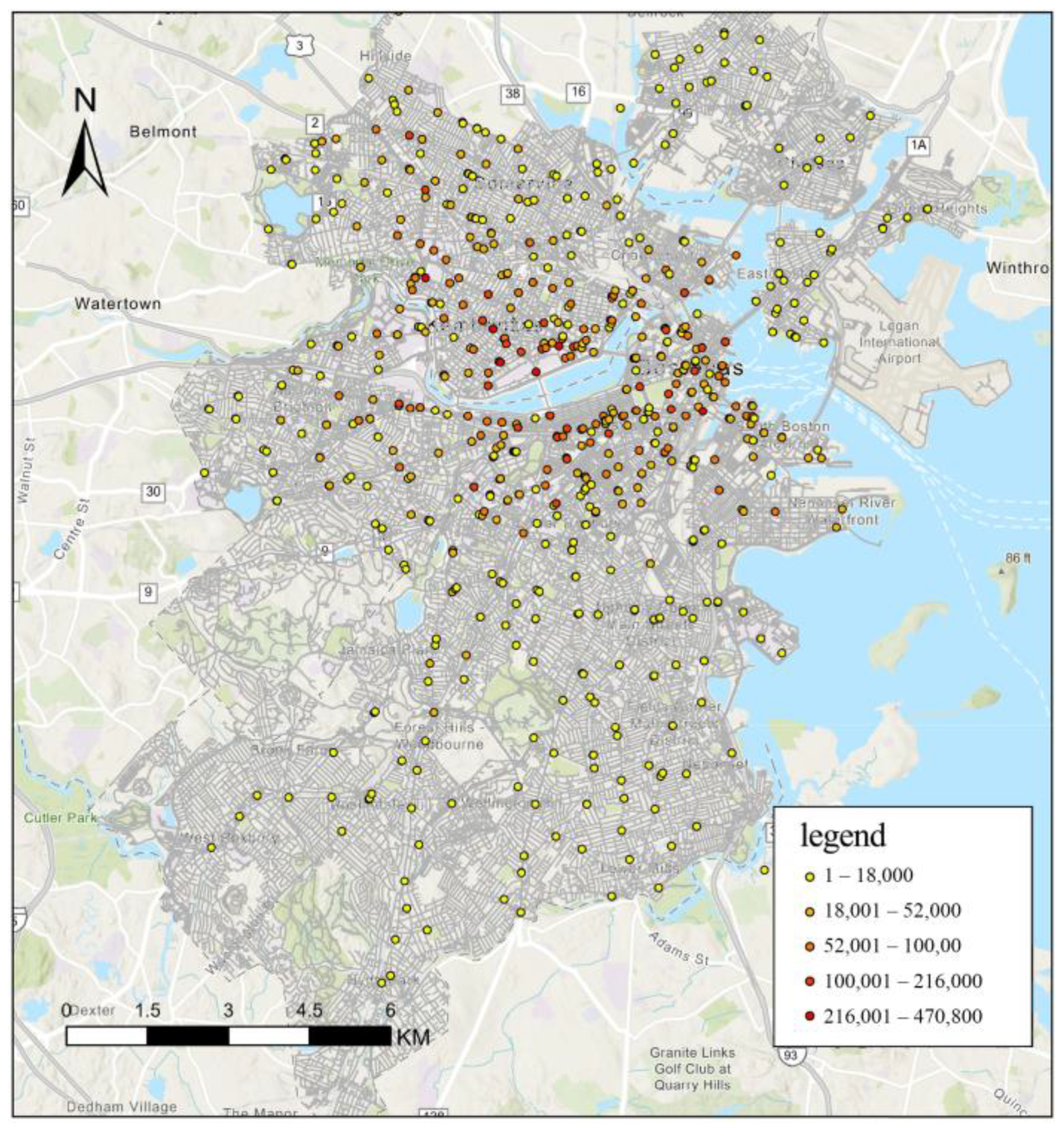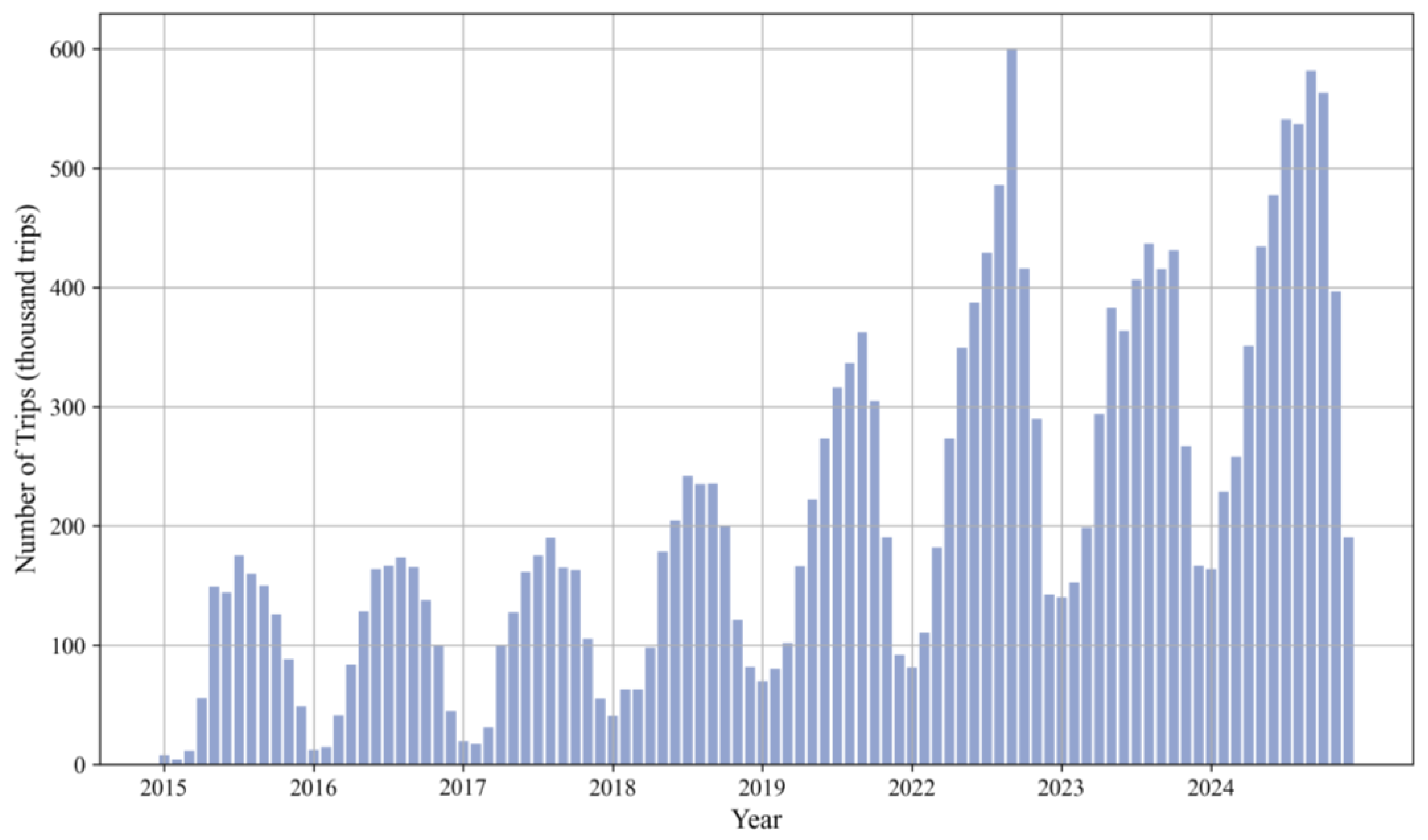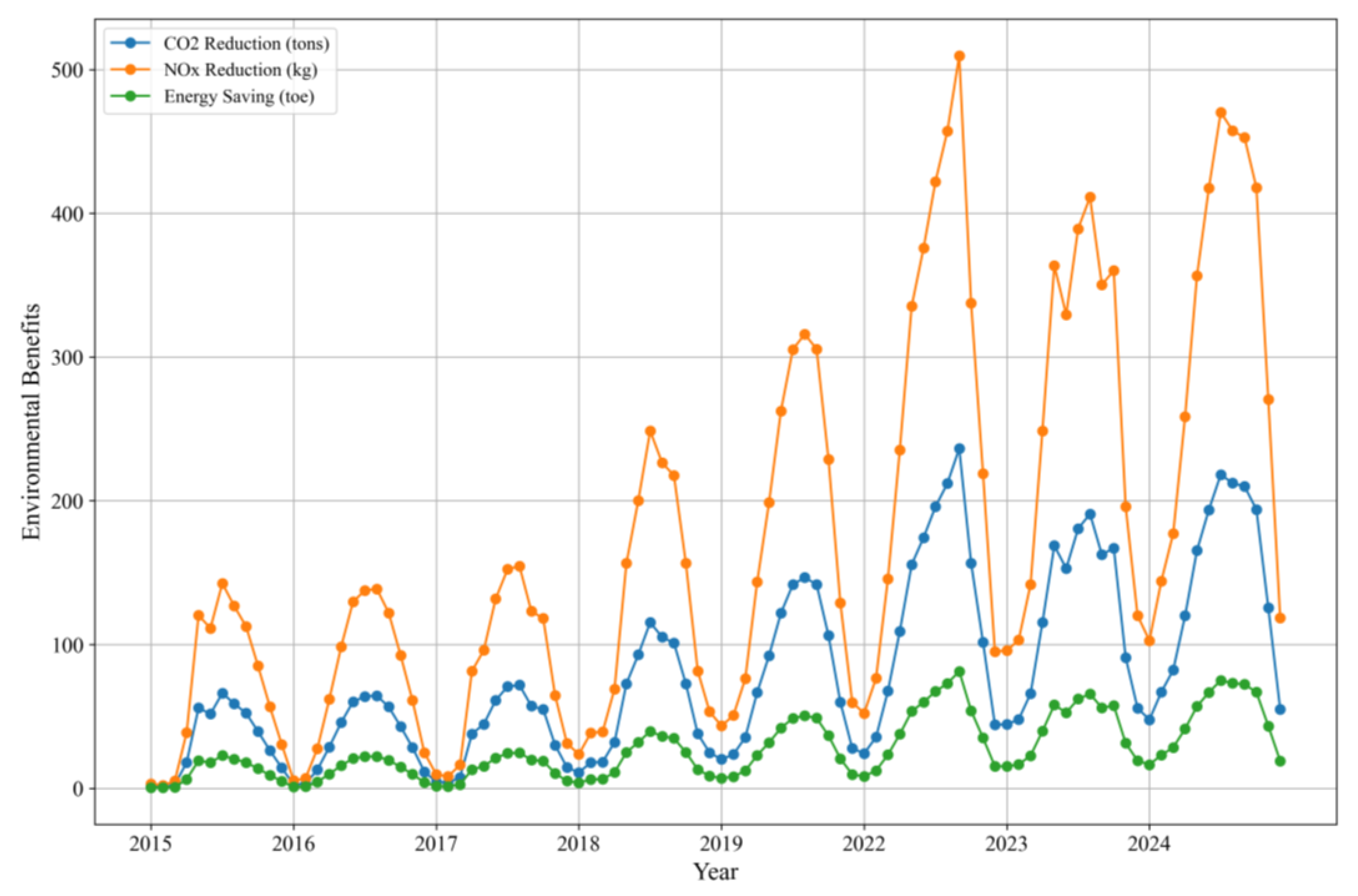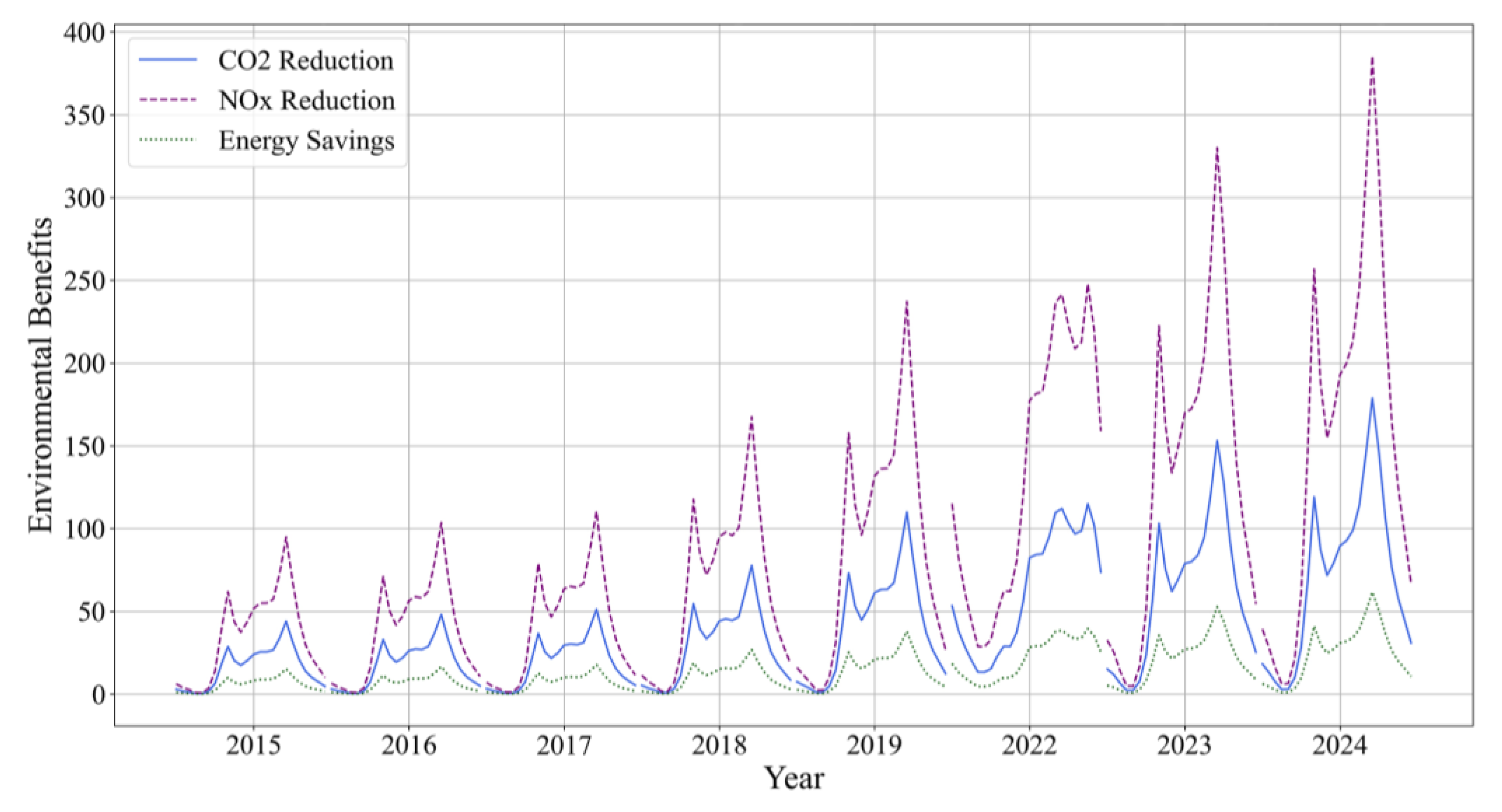Environmental Benefits Evaluation of a Bike-Sharing System in the Boston Area: A Longitudinal Study
Abstract
1. Introduction
2. Literature Review
2.1. The Environmental Benefits of Bike-Sharing Systems
2.2. The Spatiotemporal Distribution of Bike-Sharing Usage
2.3. The Prediction of Bike-Sharing’s Environmental Benefits
3. Data and Methods
3.1. Study Area and Data Source
3.2. Estimating Bluebikes’ Spatiotemporal Distributions
- Bicycle network construction: Cyclable roads with administrative boundaries of the Boston area were extracted from OpenStreetMap using OSMnx. The cycling network was then constructed using the Network Analysis function in ArcGISpro (Version: 3.15);
- Data integration: Station and trip data were geocoded and spatially joined to the constructed bicycle network in ArcGISpro, ensuring spatial alignment for subsequent analysis;
- Trip distance calculation: Trip origin and destination coordinates were defined separately as (Olon, Olat) and (Dlon, Dlat). The nearest points on the cycling network for these coordinates were identified, and the shortest paths for cycling trips were computed using Dijkstra’s algorithm in ArcGISpro;
- Station distribution visualization: The number of rented/returned bicycles at each station was calculated and visualized using point features with graduated symbols and color coding to represent usage intensity. This step was also conducted in ArcGISpro;
- Temporal pattern analysis: The trip data were imported into PyCharm (Version: 23.4), with start and end times converted into datetime format. Time information was extracted to calculate the number of trips per hour, day, and month. The temporal distribution of Bluebikes trips was visualized using the matplotlib library.
3.3. Evaluating Environment Benefits
3.3.1. Modal Substitution
3.3.2. Energy Saving and Emission Reduction
3.4. Predicting 3-Year Potential Usage and Environmental Impacts
- Localized emission factors (CO2: 0.349 kg/kWh, NOX: 0.206 g/kWh) were integrated to quantify Boston-specific emission reductions precisely;
- Data refinement: A 99.9th percentile threshold was applied to exclude trip durations exceeding 1.0 h, with missing values addressed through linear interpolation;
- Weekly cyclicity integration via explicit seasonal decomposition (s = 168 h, corresponding to 7-day cycles) to better capture Boston’s cycling patterns.
4. Results and Discussion
4.1. The Spatiotemporal Characteristics of Bluebikes
4.2. The Environmental Benefits of Bluebikes
4.3. The 3-Year Predictions of Bluebikes
5. Conclusions
Author Contributions
Funding
Data Availability Statement
Conflicts of Interest
References
- Zhang, L.; Long, R.; Li, W.; Wei, J. Potential for Reducing Carbon Emissions from Urban Traffic based on the Carbon Emission Satisfaction: Case Study in Shanghai. J. Transp. Geogr. 2020, 85, 102733. [Google Scholar] [CrossRef]
- Ricci, M. Bike sharing: A Review of Evidence on Impacts and Processes of Implementation and Operation. Res. Transp. Bus. Manag. 2015, 15, 28–38. [Google Scholar] [CrossRef]
- Clockston, R.L.M.; Rojas-Rueda, D. Health Impacts of Bike-sharing Systems in the US. Environ. Res. 2021, 202, 111709. [Google Scholar] [CrossRef]
- Lu, T.; Xu, Y.; Chen, L.; Lu, L.; Ren, R. The Potential of Carbon Reductions of Public Bikes. Sustainability 2022, 14, 14831. [Google Scholar] [CrossRef]
- Qiu, L.Y.; He, L.Y. Bike Sharing and the Economy, the Environment, and Health-Related Externalities. Sustainability 2018, 10, 1145. [Google Scholar] [CrossRef]
- Bocken, N.M.; Short, S.W.; Rana, P.; Evans, S. A Literature and Practice Review to Develop Sustainable Business Model Archetypes. J. Clean. Prod. 2014, 65, 42–56. [Google Scholar] [CrossRef]
- Frade, I.; Ribeiro, A. Bike-sharing Stations: A Maximal Covering Location Approach. Transp. Res. Part A Policy Pract. 2015, 82, 216–227. [Google Scholar] [CrossRef]
- Pfrommer, J.; Warrington, J.; Schildbach, G.; Morari, M. Dynamic Vehicle Redistribution and Online Price Incentives in Shared Mobility Systems. Trans. Intell. Transp. Syst. 2014, 15, 1567–1578. [Google Scholar] [CrossRef]
- Chen, J.; Zhou, D.; Zhao, Y.; Wu, B.; Wu, T. Life Cycle Carbon Dioxide Emissions of Bike Sharing in China: Production, Operation, and Recycling. Resour. Conserv. Recycl. 2020, 162, 105011. [Google Scholar] [CrossRef]
- Alfaris, R.E.; Patel, D.; Jalayer, M.; Meenar, M. Barriers Associated with the First/Last Mile Trip and Solutions to Bridge the Gap: A Scoping Literature Review. Transp. Res. Rec. J. Transp. Res. Board 2024, 2678, 38–48. [Google Scholar] [CrossRef]
- City of Boston. Greenhouse Gas Emissions Inventory 2005–2021; City of Boston: Boston, MA, USA, 2022.
- Martin, E.W.; Shaheen, S.A. Evaluating Public Transit Modal Shift Dynamics in Response to Bikesharing: A Tale of Two US Cities. J. Transp. Geogr. 2014, 41, 315–324. [Google Scholar] [CrossRef]
- Yang, Q.; Cai, J.; Feng, T.; Liu, Z.; Timmermans, H. Bikeway Provision and Bicycle Commuting: City-Level Empirical Findings from the US. Sustainability 2021, 13, 3113. [Google Scholar] [CrossRef]
- Fishman, E.; Washington, S.; Haworth, N. Bike Share’s Impact on Car Use: Evidence from the United States, Great Britain, and Australia. Transp. Res. Part D Transp. Environ. 2014, 31, 13–20. [Google Scholar] [CrossRef]
- Zhi, D.; Sun, H.; Lv, Y.; Xu, G. Quantifying the Comprehensive Benefit of the Bike-sharing System under Cycling Behavior Differences. J. Clean. Prod. 2022, 379, 134660. [Google Scholar] [CrossRef]
- Zheng, F.; Gu, F.; Zhang, W.; Guo, J. Is Bicycle Sharing an Environmental Practice? Evidence from a Life Cycle Assessment based on Behavioral Surveys. Sustainability 2019, 11, 1550. [Google Scholar] [CrossRef]
- Mao, G.; Hou, T.; Liu, X.; Zuo, J.; Kiyawa, A.H.I.; Shi, P.; Sandhu, S. How can Bicycle-sharing Have a Sustainable Future? A Research based on Life Cycle Assessment. J. Clean. Prod. 2021, 282, 125081. [Google Scholar] [CrossRef]
- Kou, Z.; Cai, H. Understanding Bike Sharing Travel Patterns: An Analysis of Trip Data from Eight Cities. Phys. A Stat. Mech. Its Appl. 2019, 515, 785–797. [Google Scholar] [CrossRef]
- Kou, Z.; Wang, X.; Chiu, S.F.A.; Cai, H. Quantifying Greenhouse Gas Emissions Reduction from Bike Share Systems: A Model Considering Real-World Trips and Transportation Mode Choice Patterns. Resour. Conserv. Recycl. 2020, 153, 104534. [Google Scholar] [CrossRef]
- Zhang, L. A Study on Carbon Emission Reduction of Urban Bike Sharing Based on Carbon Inclusivity: A Case Study of Beijing. Urban Public Transp. 2021, 5, 43–46. [Google Scholar] [CrossRef]
- Cheng, B.; Li, J.; Su, H.; Lu, K.; Chen, H.; Huang, J. Life Cycle Assessment of Greenhouse Gas Emission Reduction through Bike-sharing for Sustainable Cities. Sustain. Energy Technol. Assess. 2022, 53, 102789. [Google Scholar] [CrossRef]
- Zhang, Y.; Mi, Z. Environmental Benefits of Bike Sharing: A Big Data-based Analysis. Appl. Energy 2018, 220, 296–301. [Google Scholar] [CrossRef]
- Cao, Y.; Shen, D. Contribution of Shared Bikes to Carbon Dioxide Emission Reduction and the Economy in Beijing. Sustain. Cities Soc. 2019, 51, 101749. [Google Scholar] [CrossRef]
- Faghih-Imani, A.; Eluru, N. Determining the Role of Bicycle Sharing System Infrastructure Installation Decision on Usage: Case Study of Montreal BIXI System. Transp. Res. Part A Policy Pract. 2016, 94, 685–698. [Google Scholar] [CrossRef]
- Diao, M.; Song, K.; Liu, Z.B. The Environmental Benefits of Dockless Bike Sharing Systems for Commuting Trips. Transp. Res. Part D Transp. Environ. 2023, 124, 103959. [Google Scholar] [CrossRef]
- Gebhart, K.; Noland, R.B. The Impact of Weather Conditions on Bikeshare Trips in Washington, DC. Transportation 2014, 41, 1205–1225. [Google Scholar] [CrossRef]
- Vogel, P.; Greiser, T.; Mattfeld, D. Understanding Bike-sharing Systems using Data Mining: Exploring Activity Patterns. Procedia—Soc. Behav. Sci. 2011, 20, 514–523. [Google Scholar] [CrossRef]
- Xu, C.; Ji, J.; Liu, P. The Station-Free Sharing Bike Demand Forecasting with a Deep Learning Approach and Large-Scale Datasets. Transp. Res. Part C Emerg. Technol. 2018, 95, 47–60. [Google Scholar] [CrossRef]
- Kaspi, M.; Raviv, T.; Tzur, M. Detection of Unusable Bicycles in Bike-sharing Systems. Omega 2016, 65, 10–16. [Google Scholar] [CrossRef]
- Cheng, H.; Li, M.; Zhang, H. Research on the Urban Bike-sharing Usage Based on ARIMA Model. J. Urban Transp. 2023, 29, 512–526. [Google Scholar] [CrossRef]
- Fan, Y. Demand Prediction of Bike-sharing in Urban Center of Shanghai Based on SARIMA Model. Inf. Comput. 2024, 36, 210–214. [Google Scholar]
- Yu, L.; Feng, T.; Li, T.; Cheng, L. Demand Prediction and Optimal Allocation of Shared Bikes Around Urban Rail Transit Stations. Urban Rail Transit 2022, 9, 57–71. [Google Scholar] [CrossRef] [PubMed]
- Wang, Z.; Yu, D.; Zheng, X.; Meng, F.; Wu, X. A Model-Data Dual-Driven Approach for Predicting Shared Bike Flow near Metro Stations. Sustainability 2025, 17, 1032. [Google Scholar] [CrossRef]
- Dong, L.; Jiang, H.; Li, W.; Qiu, B.; Wang, H.; Qiu, W. Assessing Impacts of Objective Features and Subjective Perceptions of Street Environment on Running Amount: A Case Study of Boston. Landsc. Urban Plan. 2023, 235, 104756. [Google Scholar] [CrossRef]
- Handy, S. Making US Cities Pedestrian-and Bicycle-Friendly. In Transportation, Land Use, and Environmental Planning; Elsevier: Amsterdam, The Netherlands, 2020; pp. 169–187. Available online: https://www.sciencedirect.com/science/article/pii/B9780128151679000098 (accessed on 3 November 2024).
- De Chardon, C.M. The Contradictions of Bike-share Benefits, Purposes and Outcomes. Transp. Res. Part A Policy Pract. 2019, 121, 401–419. [Google Scholar] [CrossRef]
- Fraser, T.; Van Woert, K.; Olivieri, S.; Baron, J.; Buckley, K.; Lalli, P. Cycling Cities: Measuring Transportation Equity in Bikeshare Networks. Available at SSRN 2022. Available online: https://papers.ssrn.com/sol3/papers.cfm?abstract_id=4076776 (accessed on 3 November 2024).
- City of Boston. Go Boston 2030: Vision and Action Plan—Imagining Our Transportation Future; Boston Transportation Department: Boston, MA, USA, 2017.
- Scheiner, J. Interrelations between Travel Mode Choice and Trip Distance: Trends in Germany 1976–2002. J. Transp. Geogr. 2010, 18, 75–84. [Google Scholar] [CrossRef]
- Tang, H.; Zhou, D. Understanding the Competition and Cooperation between Dockless Bike-Sharing and Metro Systems in View of Mobility. Sustainability 2024, 16, 5780. [Google Scholar] [CrossRef]
- Teixeira, J.F.; Lopes, M. The Link between Bike Sharing and Subway Use during the COVID-19 Pandemic: The Case Study of New York’s Citi Bike. Transp. Res. Interdiscip. Perspect. 2020, 6, 100166. [Google Scholar] [CrossRef]
- Chen, Y.; Zhang, Y.; Coffman, D.M.; Mi, Z. An Environmental Benefit Analysis of Bike Sharing in New York City. Cities 2022, 121, 103475. [Google Scholar] [CrossRef]
- Cain, T. Year-End US Passenger Car Sales Ranking: Top 158 Best-Selling Cars in America. 2013. Available online: https://scholar.google.com/scholar_lookup?title=Top%20158%20best-selling%20cars%20in%20America&publication_year=2013&author=Automotive%20News%20Data%20Center (accessed on 7 December 2024).
- Speight, J.G. Production, Properties and Environmental Impact of Hydrocarbon Fuel Conversion. In Advances in Clean Hydrocarbon Fuel Processing; Elsevier: Amsterdam, The Netherlands, 2011; pp. 54–82. [Google Scholar]
- Ou, X.; Zhang, X.; Chang, S. Alternative Fuel Buses Currently in Use in China: Life-cycle Fossil Energy Use, GHG emissions and policy recommendations. Energy Policy 2010, 38, 406–418. [Google Scholar] [CrossRef]
- Yu, B.; Ma, Y.; Xue, M.; Tang, B.; Wang, B.; Yan, J.; Wei, Y.M. Environmental Benefits from Ridesharing: A case of Beijing. Appl. Energy 2017, 191, 141–152. [Google Scholar] [CrossRef]
- Intergovernmental Panel on Climate Change (IPCC). Guidelines for National Greenhouse Gas Inventories; Chapter I. Introduction; IGES Japan: Hayama, Japan, 2006; pp. 1–21. [Google Scholar]
- Ježek, I.; Katrašnik, T.; Westerdahl, D.; Močnik, G. Black Carbon, Particle Number Concentration and Nitrogen Oxide Emission Factors of Random in-use Vehicles Measured with the on-road Chasing Method. Atmos. Chem. Phys. 2015, 15, 11011–11026. [Google Scholar] [CrossRef]
- American Public Transportation Association. 2023 Public Transportation Fact Book; American Public Transportation Association: Washington, DC, USA, 2023; Available online: https://www.apta.com/research-technical-resources/transit-statistics/public-transportation-fact-book/ (accessed on 3 November 2024).
- United States Environmental Protection Agency. Emissions & Generation Resource Integrated Database (eGRID) 2021 Data; Environmental Protection Agency: Washington, DC, USA, 2023. Available online: https://www.epa.gov/egrid (accessed on 3 November 2024).
- Massachusetts Department of Transportation. Tracking the Energy and Emissions of MBTA Rapid Transit Vehicles; University of Massachusetts Amherst: Amherst, MA, USA, 2021. Available online: https://www.mass.gov/doc/tracking-the-energy-and-emissions-of-mbta-rapid-transit-vehicles-final-report/download (accessed on 3 November 2024).
- Nosal, T.; Miranda-Moreno, L.F. The Effect of Weather on the Use of North American Bicycle Facilities: A Multi-City Analysis Using Automatic Counts. Transp. Res. Part A Policy Pract. 2014, 66, 213–225. [Google Scholar] [CrossRef]
- Yang, G. State Filtered Disturbance Rejection Control. Nonlinear Dyn. 2024, 113, 6739–6755. [Google Scholar] [CrossRef]
- Yang, G.; Yao, J. Multilayer Neurocontrol of High-order Uncertain Nonlinear Systems with Active Disturbance Rejection. Int. J. Robust Nonlinear Control 2024, 34, 2972–2987. [Google Scholar] [CrossRef]








| 2015 | 2016 | 2017 | 2018 | 2019 | 2022 | 2023 | 2024 | Total | |
|---|---|---|---|---|---|---|---|---|---|
| Number of trips (million) | 1.12 | 1.23 | 1.31 | 1.76 | 2.52 | 3.75 | 3.66 | 4.72 | 20.07 |
| Number of stations | 190 | 189 | 200 | 317 | 339 | 458 | 500 | 480 | 523 |
| Trip Distance (km) | Mode Shares (%) | Trip Distance (km) | Mode Shares (%) | ||||||||
|---|---|---|---|---|---|---|---|---|---|---|---|
| Walk | Bicycle | Bus | Subway | Car | Walk | Bicycle | Bus | Subway | Car | ||
| ≤0.2 | 94.0 | 5.0 | 0.0 | 0.0 | 1.0 | 1.5–2.0 | 18.0 | 17.0 | 5.0 | 1.0 | 59.0 |
| 0.2–0.4 | 81.0 | 11.0 | 0.0 | 0.0 | 8.0 | 2.0–3.0 | 10.0 | 14.0 | 7.0 | 5.0 | 64.0 |
| 0.4–0.6 | 64.0 | 19.0 | 0.0 | 0.0 | 17.0 | 3.0–5.0 | 4.0 | 9.0 | 8.0 | 15.0 | 64.0 |
| 0.6–0.8 | 60.0 | 20.0 | 1.0 | 0.0 | 19.0 | 5.0–7.0 | 1.0 | 6.0 | 10.0 | 20.0 | 63.0 |
| 0.8–1.0 | 56.0 | 21.0 | 1.0 | 0.0 | 22.0 | 7.0–10.0 | 1.0 | 4.0 | 12.0 | 25.0 | 58.0 |
| 1.0–1.5 | 25.0 | 19.0 | 3.0 | 0.0 | 53.0 | >10.0 | 0.0 | 2.0 | 10.0 | 30.0 | 58.0 |
| p | ρ | λe | λt | η | fCO2 | fNOx | |
|---|---|---|---|---|---|---|---|
| Bus | 0.006 | 0.850 | 0.930 | 0.990 | -- | 3.090 | 0.055 |
| Car | 0.088 | 0.720 | 0.870 | 0.950 | -- | 2.930 | 0.006 |
| Subway | -- | -- | -- | -- | 0.100 | 0.349 | 0.206 |
| 2015 | 2016 | 2017 | 2018 | 2019 | 2022 | 2023 | 2024 | Total | |
|---|---|---|---|---|---|---|---|---|---|
| Average cycling distance (km) | 2.93 | 2.90 | 2.96 | 3.35 | 3.29 | 3.39 | 3.34 | 3.04 | 3.20 |
| Average cycling time (minutes) | 14.67 | 14.50 | 14.81 | 16.74 | 16.46 | 16.97 | 16.69 | 15.22 | 16.00 |
| Annual cycling time (years) | 31.42 | 34.00 | 36.92 | 56.15 | 78.82 | 120.96 | 116.05 | 136.79 | 610.95 |
Disclaimer/Publisher’s Note: The statements, opinions and data contained in all publications are solely those of the individual author(s) and contributor(s) and not of MDPI and/or the editor(s). MDPI and/or the editor(s) disclaim responsibility for any injury to people or property resulting from any ideas, methods, instructions or products referred to in the content. |
© 2025 by the authors. Licensee MDPI, Basel, Switzerland. This article is an open access article distributed under the terms and conditions of the Creative Commons Attribution (CC BY) license (https://creativecommons.org/licenses/by/4.0/).
Share and Cite
Ding, M.; Zhang, S.; Li, L.; Wu, Y.; Yang, Q.; Cai, J. Environmental Benefits Evaluation of a Bike-Sharing System in the Boston Area: A Longitudinal Study. Urban Sci. 2025, 9, 159. https://doi.org/10.3390/urbansci9050159
Ding M, Zhang S, Li L, Wu Y, Yang Q, Cai J. Environmental Benefits Evaluation of a Bike-Sharing System in the Boston Area: A Longitudinal Study. Urban Science. 2025; 9(5):159. https://doi.org/10.3390/urbansci9050159
Chicago/Turabian StyleDing, Mengzhen, Shaohua Zhang, Lemei Li, Yishuang Wu, Qiyao Yang, and Jun Cai. 2025. "Environmental Benefits Evaluation of a Bike-Sharing System in the Boston Area: A Longitudinal Study" Urban Science 9, no. 5: 159. https://doi.org/10.3390/urbansci9050159
APA StyleDing, M., Zhang, S., Li, L., Wu, Y., Yang, Q., & Cai, J. (2025). Environmental Benefits Evaluation of a Bike-Sharing System in the Boston Area: A Longitudinal Study. Urban Science, 9(5), 159. https://doi.org/10.3390/urbansci9050159






